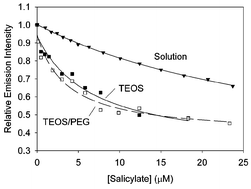Thin films (100–500 nm thick) of Class I, Class II and Class I/II organic–inorganic hybrid silicates were prepared by casting mixtures of tetraethyl orthosilicate, methyltriethoxysilane and/or dimethyldimethoxysilane that were first hydrolyzed via sonication using acid catalysis, followed by induction of gelation using added buffer solutions containing no polymer or 3% w/v of poly(ethylene glycol). In some cases, the fluorescent probe 6-propionyl-2-dimethylaminonaphthalene (PRODAN) or the protein human serum albumin (HSA) were also added to the buffer solution, which permitted the fluorescence probing of the internal environment and biological activity within the various silicate films, respectively. Parameters such as the type and level of organosilane precursor, polymer level, casting speed, and aging time were varied to determine how such factors affected the thickness, morphology, and internal environment of the resulting films that were formed by this two-step process. The results show that composite films evolve in two stages: (1) rapid drying during the initial 1–2 h after casting of the film, followed by (2) a slower aging process that continues for many months. The aging of these thin films is different to that of bulk materials and the final state of the films can be quite different from that obtained for bulk materials. Preliminary studies of HSA-doped films show that the entrapped protein adopts a partially expanded conformation, but in most cases is still able to bind to ligands.

You have access to this article
 Please wait while we load your content...
Something went wrong. Try again?
Please wait while we load your content...
Something went wrong. Try again?


 Please wait while we load your content...
Please wait while we load your content...